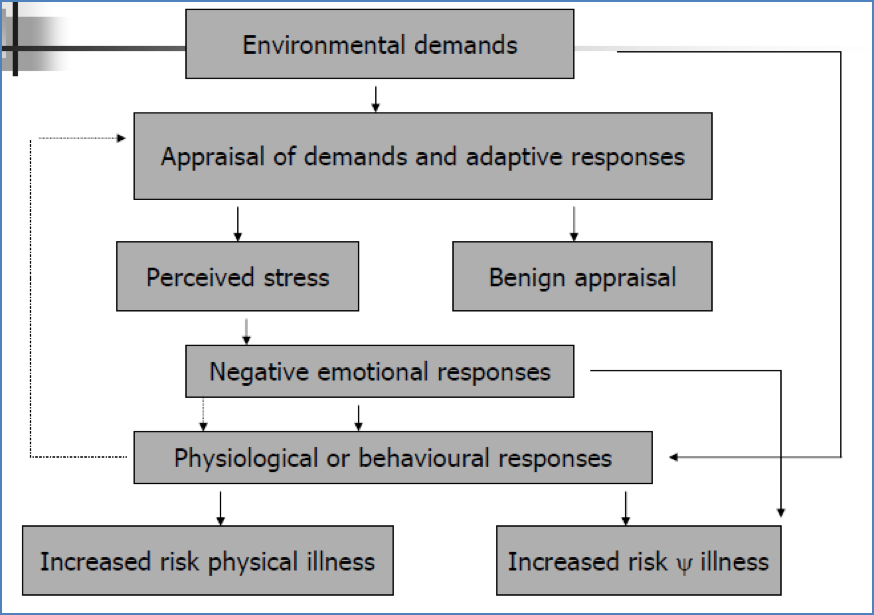Table of Contents
Overview – Stress & Coping
Stress and coping are central concepts in understanding psychological and physiological wellbeing. Stress occurs when perceived demands exceed an individual’s capacity to cope. It triggers adaptive or maladaptive responses that can impact physical health, mental health, and performance. This guide explores the stress response, resilience factors, stress-related disorders, and clinical strategies for stress management.
Definition
Stress is a state of forced change or disequilibrium, arising when external or internal demands exceed the available coping resources.
Common Stressors:
- Biological: illness, injury, fatigue
- Psychological: embarrassment, anxiety
- Social: migration, social change
- Cultural: culture shock, loss of traditions
Responses to Stress
The Three Fs:
- Fight – confront the challenge
- Flight – avoid or escape
- Freeze – become immobilised (may be maladaptive; linked to learned helplessness)
Fight-or-Flight Response
Physiological Effects
- Adrenaline/Noradrenaline:
- ↑ Heart rate
- ↑ Respiratory rate
- ↑ Oxygen delivery
- Cortisol (Stress Hormone):
- ↑ Blood glucose via gluconeogenesis
- Glucose-sparing effect on muscles and adipose
- May also promote glycogen storage if glucose is sufficient
Neurological Effects
- Heightened arousal and alertness
Yerkes-Dodson Law
Describes a bell-shaped relationship between stress and performance:
- Moderate arousal = peak performance
- Too little or too much stress = poor performance
Stress is adaptive—up to a point.


Resilience to Stress
1. Psychological Coping Strategies
- Adaptive:
- Humour
- Suppression (temporary emotional shelving)
- Sublimation (channelling stress into a productive outlet)
- Maladaptive:
- Repression, Denial, Projection, Passive aggression
2. Physical Factors
- Good general health and fitness support resilience to pain, fatigue, and depression
3. Social Factors
- High SES, social class
- Support networks: friends, family, spiritual communities
4. Cultural Factors
- Belief systems: “It was meant to be”
- Rituals: funerals, rites of passage, last rites
Dissociation
Also called psychogenic amnesia, this refers to a breakdown in memory, identity, and self-perception—often a defence against trauma.
Taylor’s Model of Stress
Illustrates how stress contributes to both psychological and physical illness, affecting immune, cardiovascular, and neuroendocrine systems.


Disorders Associated with Stress
Psychological
Precipitated by Stress:
- Post-traumatic stress disorder (PTSD)
- Dissociative disorders (e.g. multiple personalities)
- Substance misuse
Worsened by Stress:
- Depression
- Psychotic disorders (e.g. schizophrenia)
- Addictions
- Eating disorders
- Anxiety disorders
Physical
Triggered by Stress:
- Vomiting, pain
- Hypertension
- Eating issues
Exacerbated by Stress:
- Myocardial infarction
- Poor wound healing
- Gastric ulcers
Stress Management
Cognitive-Behavioural Coping Strategies
- Relaxation: slow breathing, progressive muscle relaxation
- Reframing: changing perspective (e.g. seeing the glass as half full)
- Distraction: music, prayer, exercise
- Self-esteem building
Components of a Structured Stress Management Program
- Time Management:
- Prioritisation → Scheduling → Execution
- Problem Solving:
- Define → Generate options → Select realistic ones → Rank by feasibility → Act
- Relaxation Techniques:
- Progressive muscle relaxation
- Controlled breathing
- Music and guided imagery
- Behaviour Modification:
- Recognise problem behaviours
- Practice new behaviours privately → Reinforce with social support
- Cognitive Therapy:
- Identify dysfunctional thoughts (e.g. negative appraisals)
- Challenge and replace with adaptive beliefs
- Promote sustainable coping styles
Summary – Stress & Coping
Stress and coping influence mental and physical wellbeing. Stress arises from imbalanced demands and resources, leading to a range of psychological and physiological effects. Adaptive coping, social support, and cognitive-behavioural strategies form the foundation of effective stress management. For a broader context, see our Psychiatry & Mental Health Overview page.